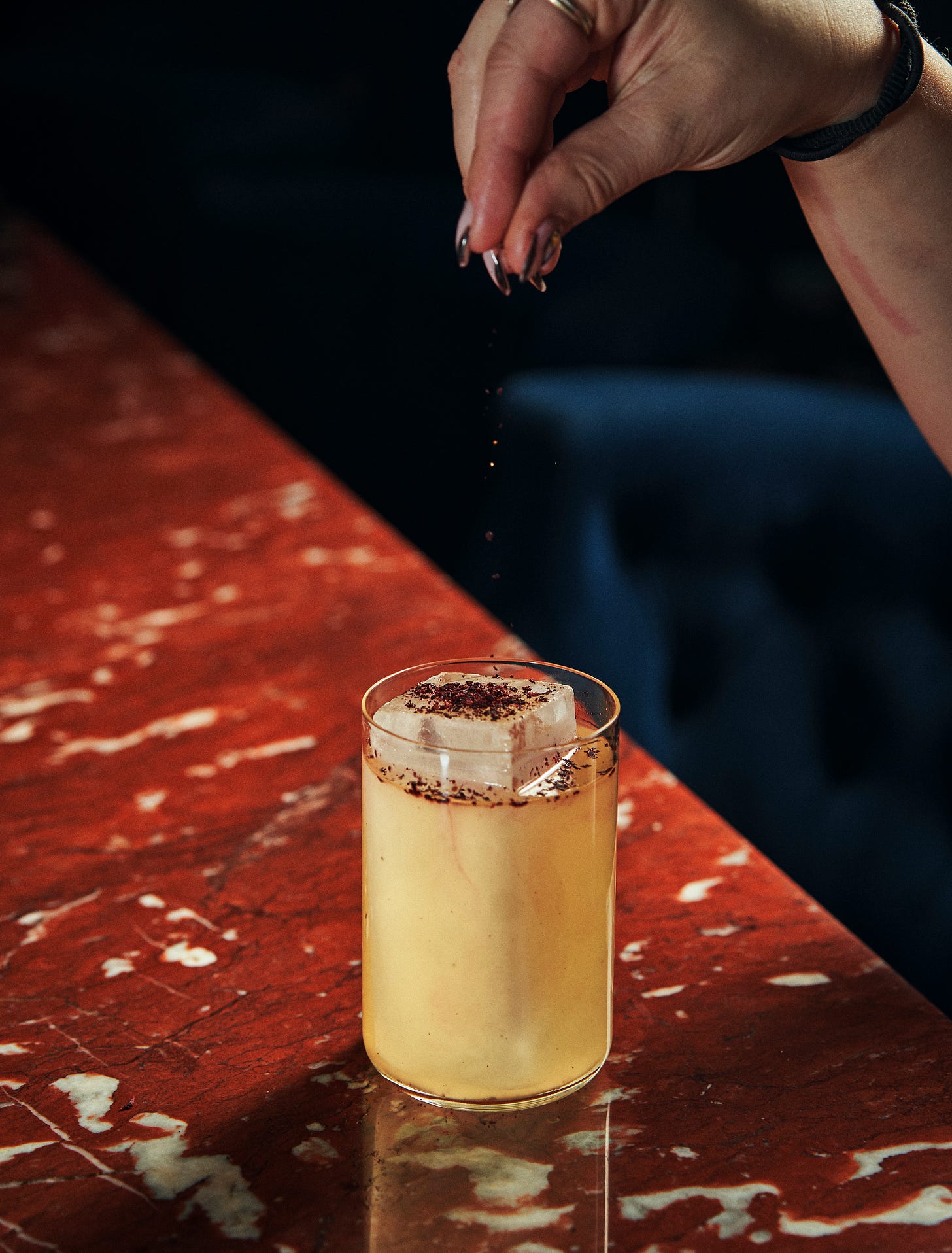Making Tepache + Tonic With Indigenous Hospitality Advocate Chockie Tom
Learn about tepache and Chockie Tom's groundbreaking, all-Indigenous bar takeover championing Native American ingredients and culture.
Onboarding
If you’ve just boarded this drink-filled mess of a newsletter, welcome, tipsy traveler! Since you probably missed the “Itinerary” newsletter explaining what to expect from “The Great American Road Trip” theme, I recommend reading that newsletter (link below) for some context. But, basically, y’all gettin’ some serious ‘Murica content delivered straight to your inbox.
If you’ve enjoyed the content I’ve been publishing on The Tipsy Traveler, you can support my efforts by engaging it by liking, commenting or sharing, or upgrading to a Paid Subscription.
Monthly: $5.00
Annual: $50.00
Founding Member: $150.00 (Annual subscription, plus some other benefits.)
Following the Cornsilk Road, an All Indigenous Bar Takeover
In April at Little Red Door in Paris (#5 on the World’s 50 Best List), Chockie Tom, an Indigenous Hospitality Advocate with Native American heritage, organized the world’s first all-Indigenous bar takeover — a session that’s a part of a greater series called the Cornsilk Road.
As I’m in the midst of covering the range and diversity of America’s cocktail culture in various capacities through my “Great American Road Trip” theme, I’d be remiss to not spotlight how indigenous hospitality advocates are educating the bar industry from their especially rare and valuable perspectives and experiences. Without diving down the dark colonialism rabbit hole upon which the United States and most of North America has been founded, it’s important to acknowledge and own the horrific details of our colonial ancestors’ pasts.
The work Chockie and her colleagues are doing is ensuring that there’s visibility for the indigenous American communities and awareness of their foodways, ingredients and cultures through an education seminar and insightful bar takeover using indigenous ingredients. It’s impressive, impactful work that deserves recognition.(Read Chockie’s story on Punch for some more perspective on her work in the bar industry.)
The series was dubbed the Cornsilk Road because the team — which includes Native American bartenders Nobian Henen, Chockie Tom, Acadia Ceris Cutschall, and Lucas Herrera — has traced the story of corn from its earliest cultivation in Mexico along pre-colonial trade ways, all the way to how corn has become one of the three most important grains in the world. And the cocktails featured on the takeover menu were all designed from a unique indigenous perspective that drew on centuries of cultivation, flavor, and sustainable practices.
"Indigenous American culinary tradition is one of the oldest and most diverse in the world; however, it is largely unknown,” says Chockie Tom. “We are thrilled to be bringing its rich history and culture to Paris to share how our ingredients have shaped the international food and drinks landscape." The groundbreaking event featured a range of cocktails made with Indigenous ingredients, including corn, quinine, and squash, while showcasing the diversity and complexity of Indigenous culinary traditions.
And for my cocktail curious tipsy travelers, Chockie has been kind enough to share one of the serves from the series with me to share with all of you to try at home. Follow her on Instagram via the button below.
Making Tepache + Tonic
Tepache, a low-ABV fermented beverage typically made from pineapple flesh and rinds has been a trendy ingredient in cocktail culture, but few people are aware of its origins. Despite the common version being made from pineapple, tepache was originally made with corn. Its name comes from the Nahuatl (also known as Aztec) "tepiātl," which means "maize drink."
The original recipe can still be found in some small rural communities in Mexico, but today you’ll find tepache made with pineapple peels, water, piloncillo sugar, cinnamon and cloves. This recipe by Roxanne Fernandez Tiburolobo (he/they), an Indigenous Brewer and Distiller of Chirichaua Apache and Rarámuri decent that works at Sonoma Distilling in California, is a version of tepache that was featured in a cocktail at the all-Indigenous bar takeover at Little Red Door in April 2023, and I’m incredibly pleased to be able to share it with you all.
Because it’s a fermented beverage the tepache takes some time and effort, but it’s fairly straightforward to make and is a great way to minimize waste while simultaneously learning about ancestral beverage practices. (You may be able to buy tepache at specialty stores, or online, but I recommend making it from scratch.) I hope you enjoy!
Tepache + Tonic by Roxanne Fernandez Tiburolobo
Ingredients:
1 1/2 oz. (75 ml) tepache*
1 1/2 oz. (75 ml) Thomas Henry Dry Tonic
1/2 oz. (15 ml) nori honey**
Garnish: pineapple frond
Directions:
Build the cocktail in a highball glass over ice and garnish.
*Tepache:
1 organic pineapple or just the skins and the core (recommended for smaller batches and/or a lower ABV or less sweet version), finely chopped
2 small or 1 large piloncillo cone (~8 oz.)
2 cloves
1 stick of Mexican cinnamon
½ teaspoon of anise seed
Filtered or distilled water to cover all ingredients, typically 3 to 4 quarts
Directions:
In a small saucepan, combine the piloncillo sugar, cinnamon stick, cloves, anise, and 1 cup water. Set it over high heat and bring it to just under a boil—large bubbles should start to form around the edges. Immediately reduce the heat to low, stirring constantly to dissolve the sugar. Once the sugar has dissolved, remove the saucepan from the heat and let the mixture cool to room temperature.
Gently rinse the outside of your pineapple with running water making sure to remove any dirt, debris, and possible pesticide residue, but not too rough to remove the wild yeast needed to start the fermentation. Remove the top, and cut the rest of the pineapple into ~1 inch cubes (including the skin and core), and place in a large glass, clay, or stainless steel vessel.
Add the cooled syrup and the remaining water. Stir to combine.
Simply cover the container with a clean cheesecloth or tea towel, using a rubber band to secure it, and place the container in a warm spot away from sunlight. The ideal temperature is between 70°F and 80°F.
Fermentation should complete within 2-5 days depending on temperature (fermentation occurs quicker at warmer temperatures). There should be a balance of sour, sweet, and light carbonation. (If you taste vinegar then you've gone too far!). The tepache can then be strained, and stored in the fridge for up to a week.
If you’re a visual learner, watch this video on how to make tepache.
**Nori seaweed honey:
1/2 cup water
1/2 cup local honey
1/2 cup white granulated sugar
Half a nori sheet, roughly cut into 2 cm pieces
Directions: In a saucepan, combine water, honey, sugar, and nori pieces. Gently stirring, bring to a boil, then immediately take off the heat and strain through a fine strainer. Let cool to room temp, then bottle. Syrup will keep in the fridge for 7 days.



